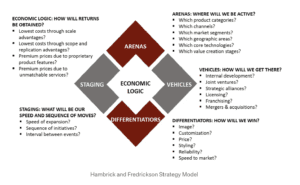What is it?
The Strategy Diamond is a framework developed by Donald C. Hambrick and James W. Fredrickson. It is a strategic management tool used to analyze and communicate a firm’s strategy. The Strategy Diamond consists of five key elements:
- Arenas: This represents the broad markets or industries in which a company chooses to compete. It defines where the company operates and the scope of its activities.
- Vehicles: Vehicles refer to the specific methods or approaches a company uses to compete in its chosen arenas. These methods can include mergers and acquisitions, partnerships, alliances, or organic growth.
- Differentiators: Differentiators are the unique factors or attributes that set a company apart from its competitors. They define how the company intends to win in its chosen markets.
- Staging: Staging refers to the sequence and timing of a company’s strategic moves. It outlines the steps or phases a company will go through to implement its strategy.
- Economic Logic: Economic logic defines how a company intends to generate profits and create value for its stakeholders. It includes the revenue and cost structure of the business.
The Strategy Diamond is a powerful tool for developing and communicating a comprehensive strategic plan. It helps organizations clarify their strategic intent, align their resources, and make informed decisions about their competitive positioning. By examining each of these five elements, businesses can create a more holistic and actionable strategy.

Example
Let’s use a chocolate shop as an example to explain each element of the Strategy Diamond:
- Arenas:
- Arenas define where a company will compete. For a chocolate shop, the arenas could include:
- Geographic locations (e.g., city, neighborhood, or online delivery).
- Dining options (e.g., dine-in, takeout, or delivery).
- Target customer segments (e.g., families, college students, or professionals).
- Types of cuisine (e.g., traditional Italian, gourmet, or vegan).
In this case, the chocolate shop’s arenas might be “Geographic locations: City and suburbs” and “Dining options: Dine-in, takeout, and delivery.”
- Arenas define where a company will compete. For a chocolate shop, the arenas could include:
- Differentiators:
- Differentiators are the factors that set a company apart from its competitors. For a chocolate shop, these could include:
- Unique recipes or signature chocolate flavors.
- Exceptional customer service.
- Speedy delivery.
- Affordable pricing.
- Health-conscious menu options.
The differentiators might include “Unique recipes and signature flavors” and “Exceptional customer service.”
- Differentiators are the factors that set a company apart from its competitors. For a chocolate shop, these could include:
- Vehicles:
- Vehicles refer to how a company will deliver its offerings and achieve its strategic goals. In the case of a chocolate shop, vehicles might include:
- Physical locations (brick-and-mortar stores).
- An online ordering platform and website.
- Third-party delivery services like UberEats or DoorDash.
- Marketing and advertising campaigns.
In this scenario, the vehicles could be “Physical locations” and “Online ordering platform.”
- Vehicles refer to how a company will deliver its offerings and achieve its strategic goals. In the case of a chocolate shop, vehicles might include:
- Staging and Pacing:
- Staging and pacing involve determining the timeline and sequence of actions in implementing the strategy. For a chocolate shop, this could mean:
- Opening new locations gradually over time.
- Introducing new menu items seasonally.
- Expanding marketing efforts during peak ordering hours or special events.
The staging and pacing approach might be “Gradual expansion of locations” and “Seasonal menu updates.”
- Staging and pacing involve determining the timeline and sequence of actions in implementing the strategy. For a chocolate shop, this could mean:
- Economic Logic:
- Economic logic addresses how the company will create value and generate profit. For a chocolate shop, this might involve:
- Cost management through efficient supply chain operations.
- Pricing strategies (e.g., competitive pricing or premium pricing for gourmet options).
- Revenue streams from dine-in, takeout, and delivery sales.
The economic logic could be “Cost-effective supply chain management” and “Multiple revenue streams.”
- Economic logic addresses how the company will create value and generate profit. For a chocolate shop, this might involve:
By using the Strategy Diamond framework, the chocolate shop can clearly define its strategic elements and ensure they are aligned. For example, if the shop aims to differentiate itself through unique chocolate flavors, it should make sure this aligns with its chosen arenas, vehicles, staging, and economic logic to create a consistent and effective strategy for success in the competitive food industry.